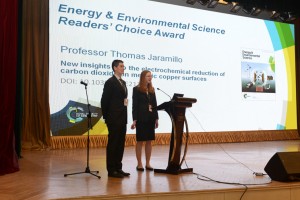A low-cost, high-efficiency technique for fabricating perovskite solar cells – ultra-sonic spray-coating – has been  developed by a team of researchers in the UK. It represents a significant step towards commercialising perovskite solar cells.
developed by a team of researchers in the UK. It represents a significant step towards commercialising perovskite solar cells.
David Lidzey, head of the research group at the University of Sheffield behind the study, explains that there has been ‘interest in developing solar cell materials that are easy to process, efficient and have less embodied energy than current technologies.’
Thin-film solar cells using perovskite semi-conductors have become a promising form of photovoltaic device achieving power conversion efficiencies of up to 15–19%, surpassing the efficiencies of amorphous silicon and organic semi-conductor photovoltaics.
Perovskite films can be fabricated by depositing precursor materials from solution. However, there have been few reports detailing the application of scalable solution-processing techniques to create these films.
In this study, an ultra-sonic spray-coating of methylamine iodide and lead chloride created a thin film of a perovskite precursor under ambient conditions. The film was then thermally annealed into a CH3NH3PbI3–ᵪClᵪ perovskite structure prior to inclusion within a solar cell with a planar heterojunction architecture.
Interested to find out more? Read the full article by Vicki Marshall in Chemistry World.
Read the original article in Energy and Environmental Science:
Efficient planar heterojunction mixed-halide perovskite solar cells deposited via spray-deposition
Alexander T. Barrows, Andrew J. Pearson, Chan Kyu Kwak, Alan D. F. Dunbar, Alastair R. Buckley and David G. Lidzey
Energy Environ. Sci., 2014, Advance Article
DOI: 10.1039/C4EE01546K



















